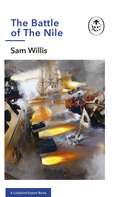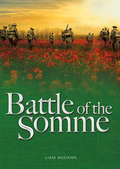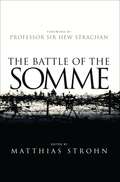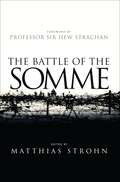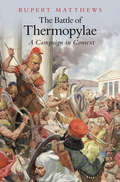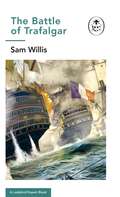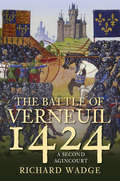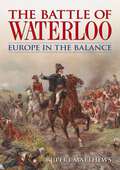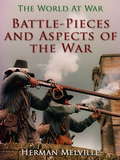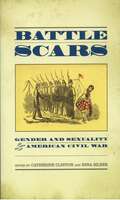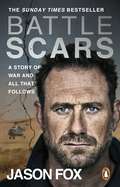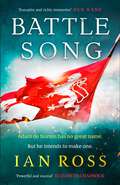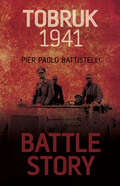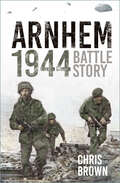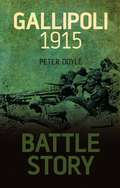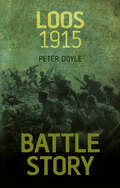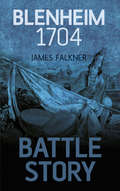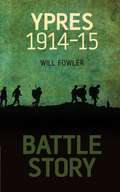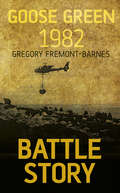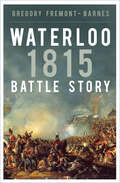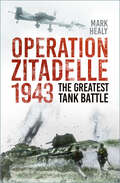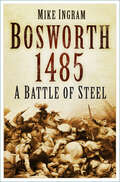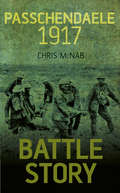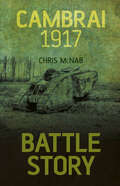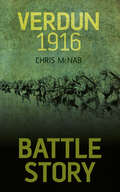- Table View
- List View
The Battle of The Nile: A Ladybird Expert Book (The Ladybird Expert Series #35)
by Sam WillisPart of the new Ladybird Expert series Nelson: Battle of the Nile is an accessible and authoritative introduction to the naval battle in that established Nelson's fame. Why was the Battle of the Nile so decisive in the French Revolutionary Wars?Why did the French believe they were unassailable?And why did Nelson and the British win?Written by historian, archaeologist, and broadcaster Sam Willis, Nelson: Battle of the Nile details the British Royal Navy's glorious defeat of the French naval expedition, thwarting Napoleon's plans to invade Egypt jeopardising Britain's trade routes and stake in India. You'll learn how the roots of this significant battle lie in the French Revolution, track Napoleon's rise to prominence and the effect of France's move from revolution to dictatorship on the balance of power in Europe. This book will take you though the dramatic turning points of the battle and Nelson's celebrated tactical leadership.The only way to stop Napoleon seemed to be at sea, and although Britain claimed victory in Aboukir Bay, the war was far from over.Written by the leading lights and most outstanding communicators in their fields, the Ladybird Expert books provide clear, accessible and authoritative introductions to subjects drawn from science, history and culture.For an adult readership, the Ladybird Expert series is produced in the same iconic small hardback format pioneered by the original Ladybirds. Each beautifully illustrated book features the first new illustrations produced in the original Ladybird style for nearly forty years.New Feature Information0
Battle of the Somme
by Liam McCannThe offensive on the Somme took place between July 1 and November 18 1916 and is arguably the most iconic battle of the Great War. Kitchener’s infamous Pals Battalions were first sent into the battlefield en masse and it was a here where many of the dreams and aspirations of a nation, hopeful of victory, were agonizingly dashed. More than three million men fought in the battle and one million men were wounded or killed, making it one of the bloodiest battles in history.
The Battle of the Somme
by Hew Strachan Jonathan Krause Matthias StrohnPublished to coincide with the centenary commemoration of the battle of the Somme, this new study comprises 12 separate articles written by some of the foremost military historians, each of whom looks at a specific aspect of the battle. Focusing on key aspects of the British, French and German forces, overall strategic and tactical impacts of the battle and with an introduction by renowned World War I scholar Professor Sir Hew Strachan, The Battle of the Somme is a timely collection of the latest research and analysis of the battle.The terrors of the Somme have largely come to embody trench warfare on the Western Front in the modern imagination, but this new book looks beyond the horrendous conditions and staggering casualty rates to provide new, insightful research on one of the most pivotal battles of the war.
The Battle of the Somme
by Sir Hew Strachan Dr Jonathan Krause Matthias StrohnPublished to coincide with the centenary commemoration of the battle of the Somme, this new study comprises 12 separate articles written by some of the foremost military historians, each of whom looks at a specific aspect of the battle. Focusing on key aspects of the British, French and German forces, overall strategic and tactical impacts of the battle and with an introduction by renowned World War I scholar Professor Sir Hew Strachan, The Battle of the Somme is a timely collection of the latest research and analysis of the battle.The terrors of the Somme have largely come to embody trench warfare on the Western Front in the modern imagination, but this new book looks beyond the horrendous conditions and staggering casualty rates to provide new, insightful research on one of the most pivotal battles of the war.
The Battle of Thermopylae: A Campaign in Context (Campaign In Context Ser.)
by Rupert Matthews‘Tell the Spartans, stranger passing by, that here obedient to their laws we lie.’ One of the most remarkable actions in ancient or modern military history took place at Thermopylae in 480BC. Rupert Matthews has personally examined the battlefield in order to try to explain how 300 Spartans could hold at bay the hordes of the Persian Emperor Xerxes. This was no vain sacrifice; the delay gave breathing space for the Greek states to organise their defence, and ultimately defend successfully their homelands. Among other intriguing revelations the author explains the importance of the half-ruined wall that sheltered the Spartans against the onslaught. With concise diagrams and maps of the entire campaign, the reader can begin to understand the extraordinary, apparently impossible outcome of the war.
Battle of Trafalgar: A Ladybird Expert Book (The Ladybird Expert Series #28)
by Sam WillisPart of the ALL-NEW LADYBIRD EXPERT SERIES- Why was the Battle of Trafalgar such an important British victory in the Napoleonic Wars? - How did the British fleet show their strength against the French and Spanish? - How did Nelson excel in his final battle?FOLLOW the daring strategy and brilliant leadership of Horatio Nelson in Britain's stunning triumph against Napoleon's forces. From the might of Britain's war machine to the death of the world's most impressive naval commander, discover why Trafalgar remains the most famous naval battle in history.BRITAIN'S GLORIOUS VICTORY, AND NELSON'S FINAL BATTLEWritten by historian, archaeologist, and broadcaster Sam Willis, The Battle of Trafalgar is gripping and accessible introduction to the battle that established Britain as a formidable seapower for many years to come.
The Battle of Verneuil 1424: A Second Agincourt
by Richard WadgeIn August 1424 the armies of England, Scotland and France met in the open fields outside the walls of Verneuil in a battle that would decide the future of the English conquests in France. The hero king, Henry V, had been dead for two years and the French felt that this was their chance to avenge their startling defeat at Agincourt, and recover the lands that Henry had won for England. Despite its importance, the battle is largely overlooked in accounts of the Hundred Years War. The Battle of Verneuil 1424 is the first proper account of the battle, and is also one of the first books to outline the important part the Scots played in the wars in France in the years between the two great battles of Agincourt and Verneuil.
The Battle of Waterloo: Europe in the Balance
by Rupert MatthewsThe Battle of Waterloo was one of the most dramatic and decisive battles ever fought. It marked the bloody end of the long struggle between the new ideals of the French Revolution and the established orders that had begun in 1793, and ushered in a century of peace in Europe.For such a massively important battle, Waterloo is all too often misunderstood, probably because the combatants have concentrated on the role of their own troops. Going back to the original sources, the author looks at the day of battle as a whole, delving behind the headline events to reveal why the battle unfolded as it did.
Battle-Pieces and Aspects of the War: Civil War Poems (The World At War)
by Herman MelvilleBattle-Pieces and Aspects of the War (1866) is the first book of poetry published by American author Herman Melville. The volume is dedicated "To the Memory of the Three Hundred Thousand Who in the War For the Maintenance of the Union Fell Devotedly Under the Flag of Their Country" and its 72 poems deal with the battles and personalities of the American Civil War and their aftermath. (Excerpt from Wikipedia)
Battle Scars: Gender and Sexuality in the American Civil War
by Catherine Clinton Nina SilberOver a decade ago, the publication of Divided Houses ushered in a new field of scholarship on gender and the Civil War. Following in its wake, Battle Scars showcases insights from award-winning historians as well as emerging scholars. This volume depicts the ways in which gender, race, nationalism, religion, literary culture, sexual mores, and even epidemiology underwent radical transformations from when Americans went to war in 1861 through Reconstruction. Examining the interplay among such phenomena as racial stereotypes, sexual violence, trauma, and notions of masculinity, Battle Scars represents the best new scholarship on men and women in the North and South and highlights how lives were transformed by this era of tumultuous change.
Battle Scars: The Sunday Times bestseller
by Jason FoxTHE EXTRAORDINARY NUMBER ONE BESTSELLER.'The most important book you'll ever read... Battle Scars will save lives.' TOM MARCUS, author of SOLDIER SPYBattle Scars tells the story of Jason Fox's career as an elite operator, from the gunfights, hostage rescues, daring escapes and heroic endeavours that defined his service, to a very different kind of battle that awaited him at home.After more than two decades of active duty, Foxy was diagnosed with complex PTSD, forcing him to leave the military brotherhood and confront the hard reality of what follows. What happens when you become your own enemy? How do you keep on fighting when life itself no longer feels worth fighting for?Unflinchingly honest, Battle Scars is a breathtaking account of Special Forces soldiering: a chronicle of operational bravery, and of superhuman courage on and off the battlefield.---'A vivid, searing account of a life at war.' BEAR GRYLLS'A must read.' ANT MIDDLETON, bestselling author of FIRST MAN IN.--- What readers are saying: 'Outstanding' *****'Inspiring' *****'Courageous' *****'Remarkable' *****'An absolute must-read' *****--- Life Under Fire, Jason Fox's powerful and inspiring new book is OUT NOW
Battle Song: The 13th century historical adventure for fans of Bernard Cornwell and Ben Kane (de Norton trilogy)
by Ian Ross'There is a fury in England that none shall suppress - and when it breaks forth it will shake the throne'1264 Storm clouds are gathering as Simon de Montfort and the barons of the realm challenge the power of Henry III. The barons demand reform; the crown demands obedience. England is on the brink of civil war. Adam de Norton, a young squire devoted to the virtues of chivalry, longs only to be knighted, and to win back his father's lands. Then a bloody hunting accident leaves him with a new master: the devilish Sir Robert de Dunstanville, who does not hesitate to use the blackest stratagems in pursuit of victory. Following Robert overseas, Adam is introduced to the ruthless world of the tournament, where knights compete for glory and riches, and his new master's methods prove brutally effective. But as England plunges into violence, Robert and Adam must choose a side in a battle that will decide the fate of the kingdom. Will they fight for the king, for de Montfort - or for themselves? Searingly vivid and richly evocative, Battle Song is tale of friendship and chivalry, rivalry and rebellion, and the medieval world in all its colour and darkness.
Battle Story: Tobruk 1941 (Battle Story Ser.)
by Pier Paolo BattistelliThe siege of Tobruk lasted 240 days during which the ‘gallant garrison’ of Allied soldiers, including the famous ‘Desert Rats’ held out against constant attacks from Rommel’s Afrika Korps. The battle became one of the longest sieges in British military history and a potent symbol of British resistance. To understand what happened and why – read Battle Story. Diary extracts and quotes offer a real insight into what it was like for the Allied soldiers to live under siege. Maps highlight the adversities of the terrain and the strategic importance of the Tobruk fortress. Rare photographs place you on the frontline of the unfolding action. Orders of battle reveal the composition of the opposing forces’ armies. Packed with fact boxes, this short introduction is the perfect way to explore this important battle.
Battle Story: El Alamein 1942 / Arnhem 1944 / Iwo Jima 1945 (Battle Story Ser. #7)
by Chris BrownWhen we think of Arnhem we think of A Bridge Too Far and a sky full of parachutes dropping the Allies into the Netherlands. Beyond these images, this was one fo the most complex and strategically important operations of the war. Operation Market Garden was devised to give the Allies the opportunity to bypass the German Siegfried Line and attack the Ruhr. Paratroopers were dropped into the Netherlands to secure all the bridgeheads and major routes along the proposed Allied axis advance. Simultaneously the 1st Airborne Division, supported by the Glider Pilot Regiment and Polish 1st Independent Parachute Brigade, landed at Arnhem. The British expected to sweep through and connect with the Arnhem force within a matter of days. However, things on the ground proved very different. The troops met resistance from pockets of SS soliders and soon were overwhelmed. The Arnhem contingent was cut-off from reinforcement and eventually forced to withdraw. The 1st Airborne Division lost three-quarters of its strength in the operation and did not see battle again. Through quotes and maps the text explores the unfolding action of the battle and puts the reader on the frontline. if you truly want to understand what happened and why - read Battle Story.
Battle Story: Gallipoli 1915 (History Press Ser.)
by Peter DoyleThe Gallipoli campaign was in some ways the brainchild of First Lord of the Admiralty, Winston Churchill, who saw an attack on the Dardanelles as a way to break through the stalemate in supplying the Eastern Front. The preceding naval campaign led many to believe that victory was inevitable. However, increased losses at sea prompted the Allies to send ground troops to invade and eliminate the Ottoman artillery. These ground forces comprised a large ANZAC (Australian and New Zealand) contingent and Gallipoli would be their first major campaign in the war. They invaded on 25 April 1915, landing on 5 stretches of beach in open boats. The casualties from the first landing were horrific, of the first 200 men out of the boats, only 21 reached inland, the rest were mown down by the Ottoman machine-guns. Throughout the campaign losses were severe, with both sides suffering casualties in excess of 200,000 troops. Eventually the Allies were forced to evacuate. The fall out from this disaster was felt in both military and political circles. Battle Story Gallipoli takes you to the frontline and beyond, ensuring that you will appreciate the ultimate sacrifice made by these WWI soldiers.
Battle Story: Loos 1915 (Battle Story Ser.)
by Peter DoyleThe Battle of Loos saw a change in Allied strategy, which up until then had been a series of small-scale assaults that achieved little or no ground gained. Loos was to be different, Kitchener’s Army was deployed in strength for the first time and an ambitious plan aimed to take ground over a 20-mile front. As the fog of war descended the first day’s gains were lost over subsequent days’ fighting and in the end the ‘Big Push’ saw little achieved with Allied losses of about 50,000 men. Through quotes and maps the text explores the unfolding action of the battle and puts the reader on the frontline. If you truly want to understand what happened and why – read Battle Story.
Battle Story: Marlborough's Greatest Victory (Battle Story Ser.)
by James FalknerBlenheim has gone down in history as one of the turning points of the War of the Spanish Succession – and some would say in the history of conflict in Europe. The overwhelming Allied victory ensured the safety of Vienna from the Franco-Bavarian army, thus preventing the collapse of the Grand Alliance. Bavaria was knocked out of the war, and Louis's hopes for a quick victory came to an end. France suffered over 30,000 casualties including the commander-in-chief, Marshal Tallard, who was taken captive to England. Before the 1704 campaign ended, the Allies had taken towns on the Moselle in preparation for the following year's campaign into France itself. It was a brilliant victory for Marlborough, which involved a lightning march of over 250 miles and superb deception – even of his own Dutch allies! Blenheim must be one of the most well known battles – because of Blenheim Palace – but few know why.
Battle Story: Ypres 1914-15 (Battle Story Ser.)
by William E FowlerYpres was a medieval town known for its textiles; however, it became infamous during the Great War with trench warfare, poison gas and many thousands of casualties. As the German Army advanced through Belgium, it failed to take the Ypres Salient. On 13 October 1914, German troops entered Ypres. On looting the city, the Germans retreated as the British Expeditionary Force advanced. On 22 November 1914, the Germans commenced a huge artillery barrage killing many civilians. In 1917, the Third Battle of Ypres commenced making it an exceptionally dangerous place to live. In 1918, a German major offensive was launched, but the British held firm. Ypres was finally safe in late September 1918 when German troops withdrew from the Salient. Today the battlefields of Ypres contain the resting place of thousands of German and British soldiers. This book explores the first and second battles of Ypres through narrative, eye-witness accounts and images.
Battle Story: Goose Green 1982 (Battle Story Ser. #4)
by Gregory Fremont-BarnesThe Battle of Goose Green was the first and longest land conflict of the Falklands War, which was fought between British and Argentine forces in 1982. The British forces, attacking over featureless, wind-swept and boggy ground, were heavily outnumbered and lacked fire support, but brilliantly defeated the Argentine garrison in a fourteen-hour struggle. If you want to understand what happened and why – read Battle Story. Detailed profiles examine the personalities of the British and Argentine commanders, including that of Victoria Cross winner Lt Col ‘H’ Jones. First-hand accounts offer an insight into this remarkable fourteen-hour struggle against the odds. Detailed maps explore the area of Darwin Hill and Goose Green, and the advance of the British forces. Photographs place you at the centre of this pivotal battle. Orders of battle show the composition of the opposing forces’ armies. Packed with fact boxes, this short introduction is the perfect way to explore this crucial battle.
Battle Story: The British Army's Day Of Destiny (Battle Story Ser. #3)
by Gregory Fremont-BarnesThe Battle of Waterloo is one of the most important moments in military history. As the might of the French Empire under the leadership of the Emperor Napoleon faced the Coalition army under Duke of Wellington and Gerhard von Blucher for one last time. The battle saw the culmination of a long campaign to destroy Napoleon's forces and halt the growth of the French Empire. Both sides fought bitterly and Wellington later remarked that 'it was the nearest-run thing you ever saw in your life'. Both armies lost over 20,000 men on the battlefield that day, but it was the coalition that emerged victorious in the end. Wellington's army counter-attacked and threw the French troops into disarray as they fled from the field. The coalition forces entered France and restored Louis XVIII to the throne and Napoleon was exiled to the island of Saint Helena, where he later died. Waterloo was a resounding victory for the British Army and changed the course of European history. This Battle Story tells you everything you need to know about his critical battle.
Battle Story: The Greatest Tank Battle In History (Armour In Theatre Ser. #No. 16)
by Mark HealyIn July 1943, Hitler launched Operation Zitadelle, the last German offensive on the Eastern Front. It was an attempt to shorten the German lines by eliminating the Kursk salient – created after their defeat at Stalingrad – and was designed to result in the encirclement of the Red Army. In reality the German tanks came up against impenetrable Russian defences: minefields, artillery and anti-tank emplacements, spread through lines 250km deep and manned by Russian troops whose actions often verged on the suicidal. The greatest tank battle in history, Kursk assured the Nazis’ defeat and was ‘the swan song of the German tank arm’. Involving over 9000 tanks, 5000 aircraft, 35,000 guns and mortars and 2,700,000 troops (of whom 230,000 became casualties), the Battle of Kursk was a conflict whose scale and barbarity eclipsed all other clashes in Europe. This book gives a clear, concise account of those dramatic days in 1943, supported by a timeline of events and orders of battle, and illustrated with over fifty photographs.
Battle Story: Bosworth 1485 (Battle Story Ser. #6)
by Mike IngramBosworth Field saw the two great dynasties of the day clash on the battlefield: the reigning House of York, led by Richard III, against the rising House of Tudor, led Henry Tudor, soon to become Henry VII. On 22 August 1485 this penultimate battle in the Wars of the Roses was fought with the might of the Lancastrian army ranged against the Yorkists. This book describes how these two great armies came to meet on the battlefield and how the tactics employed by the Yorkists eventually led to their defeat and the death of King Richard III. Through quotes and maps the text explores the unfolding action of the battle and puts the reader on the frontline. If you truly want to understand what happened and why – read Battle Story.
Battle Story: The Third Battle Of Ypres In Photographs (Battle Story Ser. #9)
by Chris McNabPasschendaele 1917 is the story of one of the most pitiless and iconic battles of the First World War, known today as Third Ypres. Fought over three tortuous months in 1917, the fighting raged through some of the worst physical conditions of the entire war, across battlefields collapsing into endless mud and blood. Eventually, more than 500,000 casualties bought front-line changes measured only in hundreds of yards. If you truly want to understand what happened and why – read Battle Story.
Battle Story: Cambrai 1917 (History Press Ser.)
by Chris McNabThe Battle of Cambrai has become synonymous with one of the Allies’ first large-scale use of tanks on the Western Front. Cambrai certainly saw over 450 Mark IV tanks lumber across No Man’s Land and penetrate the Hindenburg Line. For the Germans on the other side of these defences the sheer scale of these ‘iron monsters’ was terrifying, however they quickly rallied and the battle was about much more than the tanks deployed. Chris McNab explores how new techniques of sound-ranging and artillery strategy played a greater part on the battlefield than the tanks which have dominated the history of the battle. At dawn on 20 November 1917 over 1,000 guns fired on German positions and 400 tanks and thousands of men stepped out into the barren land between the trenches. At first, it seemed that success was inevitable, with over 5 miles of ground gained – a significant amount for such an operation, however on the first day of battle 180 tanks were out of action and the attack began to flounder. After days of attack and counterattack, both sides had gained ground, but no definitive success and with over 70,000 casualties. Yet, Cambrai was an important training ground for both sides, proving the effectiveness of new tactics that would lead to greater victories later in the war.
Battle Story: Verdun 1916 (Battle Story Ser.)
by Chris McNabThe Battle of Verdun was one of the bloodiest engagements of the First World War, resulting in 698,000 deaths, 70,000 for each of the 10 months of battle. The French Army in the area were decimated and it is often most tragically remembered as the battle in which the French were ‘bled white’. A potent symbol of French resistance, the fortress town of Verdun was one that the French Army was loath to relinquish easily. It was partly for this reason that the German commander chose to launch a major offensive here, where he could dent French national pride and military morale. His attack commenced on 21 February, using shock troops and flamethrowers to clear the French trenches. Starting with the capture of Fort Douamont, by June 1916 the Germans were pressing on the city itself, exhausting their reserves. The French continued to fight valiantly, despite heavy losses and eventually rolled back German forces from the city. In the end it was a battle that saw much loss of life for little gain on either side.
